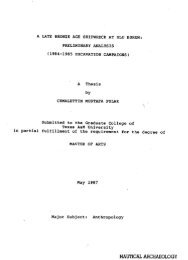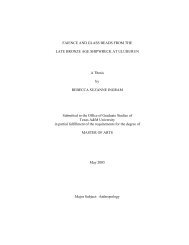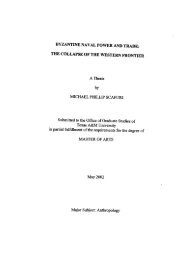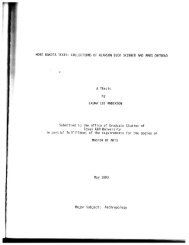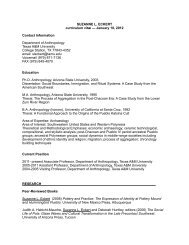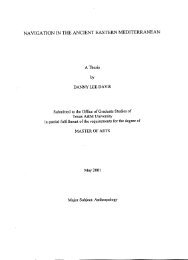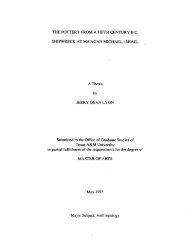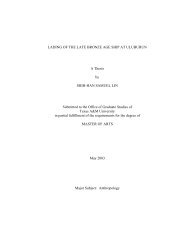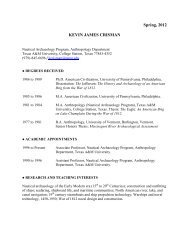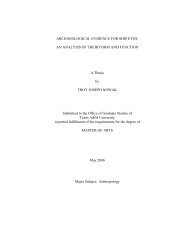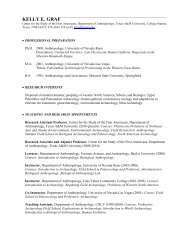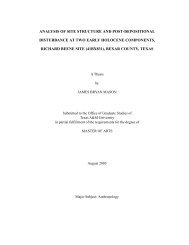- Page 1 and 2:
HUMAN SKELETAL REMAINS OF THE ANCIE
- Page 3 and 4:
iiiABSTRACTHuman Skeletal Remains o
- Page 5 and 6:
vACKNOWLEDGEMENTSThis research was
- Page 7 and 8:
viiCHAPTERPageIV SITE DESCRIPTIONS
- Page 9 and 10:
ixLIST OF FIGURESFIGUREPage1 Map of
- Page 11 and 12:
xiLIST OF TABLESTABLEPage1 Caves of
- Page 13 and 14:
2Fig. 1. Map of the Petexbatun regi
- Page 15 and 16:
4prove or disprove my hypothesis. T
- Page 19 and 20:
8Caves are also known to share an o
- Page 21 and 22:
10Artifactual materialThe artifacts
- Page 23 and 24:
12activities, which included bloodl
- Page 25 and 26:
14represented. A ceramic analysis r
- Page 27 and 28:
16based on the identification of th
- Page 29 and 30:
18when a structure is placed over o
- Page 31 and 32:
20The Copan Ritual Caves Project la
- Page 33 and 34:
22sacrificial victims. The identifi
- Page 35 and 36:
24CHAPTER IIIMATERIALS AND METHODSS
- Page 37 and 38:
26InventoryMy analysis began with a
- Page 39 and 40:
28responsible. A precise methodolog
- Page 41 and 42:
30After rounding up to the highest
- Page 43 and 44:
32and subadults are differentiated
- Page 45 and 46:
34demonstrate the practice of inter
- Page 47 and 48:
36Implements such stone tools may h
- Page 49 and 50: 38of the young woman involved the r
- Page 51 and 52: 40Fig. 3. Caves of the Petexbatun.
- Page 53 and 54: 42I) consisted of an excavation in
- Page 55 and 56: 44Cueva de Río El DuendeCueva de R
- Page 57 and 58: 46excavation uncovered evidence of
- Page 59 and 60: 48Fig. 6. Complete map of Cueva de
- Page 61 and 62: 50these remains were recovered by m
- Page 63 and 64: 52Dos Pilas as a dominant polity in
- Page 65 and 66: 54Fig. 7. Map of Cueva de Los Quetz
- Page 67 and 68: 56CHAPTER VNISP AND MNI - AN ANALYS
- Page 69 and 70: 58Cueva de El DuendeOne hundred for
- Page 71 and 72: 60feet were the most common skeleta
- Page 73 and 74: 62estimates indicate that Cueva de
- Page 75 and 76: 64skeletal elementpedal phalangemet
- Page 77 and 78: 66TABLE 4. MNI for Cueva de Río El
- Page 79 and 80: 68five rooms in Operation CNP2. Roo
- Page 81 and 82: 70CNP2-24-1CNP2-26-1CNP2-27-1CNP2-2
- Page 83 and 84: 72modification was one of the more
- Page 85 and 86: 74result from a small sample size,
- Page 87 and 88: 76material examined in this study,
- Page 89 and 90: 78TABLE 7. MNI for Cueva de Sangre.
- Page 91 and 92: 80MNI considered material from 41 l
- Page 93 and 94: 82CS9-06-1CS11-03-2CS11-03-3CS11-03
- Page 95 and 96: 84Three hundred and fifty meters of
- Page 97 and 98: 8626 individuals (Table 9). I ident
- Page 99: 88calculated an MNI at the level of
- Page 103 and 104: 92the operation and the cave seem m
- Page 105 and 106: 94between these two types of activi
- Page 107 and 108: 96represent the sample with evidenc
- Page 109 and 110: 98The second group consists of eigh
- Page 111 and 112: 100One of the deeper cut marks was
- Page 113 and 114: 102CNP2-07-1/18A complete left femo
- Page 115 and 116: 104occur throughout the bone. The f
- Page 117 and 118: 106The identification of human-made
- Page 119 and 120: 108harsh effects of the active envi
- Page 121 and 122: 110did not affect this particular b
- Page 123 and 124: 112TABLE 12. NISPs, MNIs, and PNIs
- Page 125 and 126: 114processed for secondary burial (
- Page 127 and 128: 116in mind that this and the many o
- Page 129 and 130: 118an adult male recovered from an
- Page 131 and 132: 120Cueva de Los QuetzalesThe skelet
- Page 133 and 134: 122some doubt. These assessments ba
- Page 135 and 136: 124CHAPTER VIIICONCLUSIONSThe infor
- Page 137 and 138: 126LITERATURE CITEDAnderson AH. 196
- Page 139 and 140: 128Brady JE, Rodas I. 1995. Maya Ri
- Page 141 and 142: 130Johnston FE. 1962. Growth of the
- Page 143 and 144: 132Pohl M, Pohl J. 1983. Ancient Ma
- Page 145 and 146: 134Pre-Columbian Archaeology. Oxfor
- Page 147 and 148: APPENDIX IINVENTORY FOR CUEVA DE EL
- Page 149 and 150: CD2-01-8B pelvis R complete ischium
- Page 151 and 152:
APPENDIX IIINVENTORY FOR CUEVA DE R
- Page 153 and 154:
CNP2-07-1/10 femur L prox.1/2 shaft
- Page 155 and 156:
CNP2-12-1/13 humerus R dist.1/2 sha
- Page 157 and 158:
CNP2-20-1/11 femur L nearly complet
- Page 159 and 160:
CNP2-26-1/1 long bone ? 4+ fragsCNP
- Page 161 and 162:
CNP2-28-1/35 mandible L no teeth &
- Page 163 and 164:
APPENDIX IIIINVENTORY FOR CUEVA DE
- Page 165 and 166:
CRM4-03-1/1 tibia R shaft frag, cor
- Page 167 and 168:
CS1-77-2/3 sacrum A anterior aspect
- Page 169 and 170:
CS2-11-1/2 radius R complete shaft,
- Page 171 and 172:
CS5-07-1/11 frags ? 7 fragsCS5-07-1
- Page 173 and 174:
CS9-02-1 B7 tibia L prox.2/3 shaft,
- Page 175 and 176:
CS9-04-1/3 tibia R prox.1/2 shaft,
- Page 177 and 178:
CS9-06-1/14 femur L complete shaft,
- Page 179 and 180:
CS11-05-1/3 long bone ? 15 fragsCS1
- Page 181 and 182:
CS11-05-1 grp.B/1 vertebra A centru
- Page 183 and 184:
CKP2-03-1/10 femur L complete shaft
- Page 185 and 186:
CKP2-04-1/3 femur L dist.1/2 shaft,
- Page 187 and 188:
CKP9-06-1 tibia R CKP 62-63; prox.1
- Page 189 and 190:
CQ1-10-11 upper I2 R root is formin



